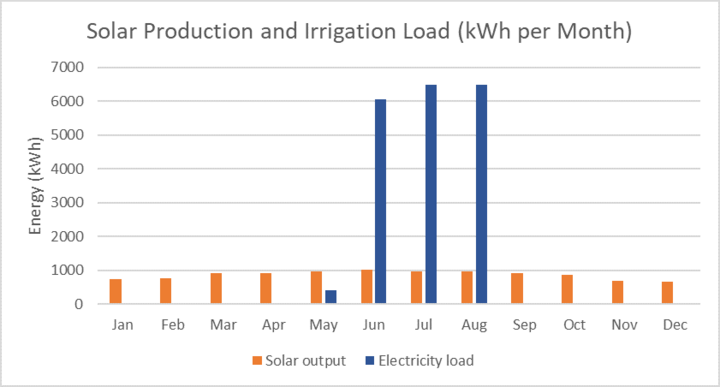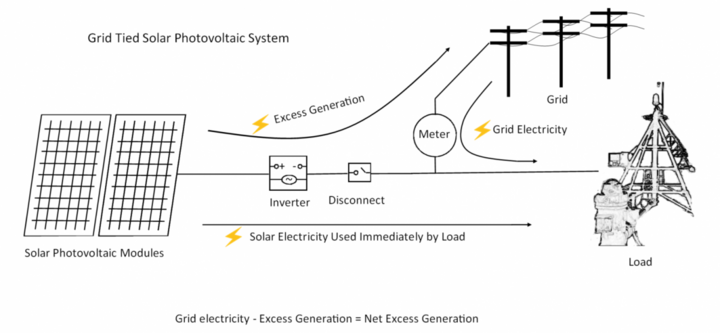Solar electric generation, often called photovoltaic (PV) and center pivot irrigation appear to be good partners. Irrigation is a major electrical cost for farms. Solar production peaks in the summer months which corresponds to irrigation pumping. Yet grid connected solar PV and irrigation are not always well suited because of the seasonality of the electric load for irrigation and the yearlong production of solar. The economic return on investment for solar electric systems attached to irrigation meters is not the same for all systems. This story will cover the overarching idea and definitions for grid connected solar PV and irrigation systems. A second article will follow which will dig deeper into the economics of these systems.
Overarching Challenge
Grid connected solar PV and irrigation are not always well suited. Solar generated electricity traveling to the grid during the off season often has lower value than solar electricity used by the irrigation system. Figure 1 shows the solar electricity production in orange and irrigation load in blue. The system size in figure 1 is sized to provide 50% of the annual load. Based on Nebraska’s net metering policy the value of off-season solar production is likely lower than the value of in-season solar production. Generally, loads that are more consistent throughout the year are a better fit for grid connected solar. Figure 2 shows a residential load with a solar array sized to provide 50% of annual load.


Introduction
The largest energy use in row crop agriculture are for fertilizer, irrigation, and grain drying. Farmers seeking greater efficiency explore and adopt management and equipment which can reduce energy use or reduce energy costs. Farmers across the US are exploring solar PV as a way to reduce energy costs. Thousands have built solar PV systems, yet adoption of solar PV may not be right for everyone. This article contains an evaluation of grid connected (behind the meter) solar PV technology for center pivot irrigation. Addition of solar is rarely a replacement for the electric grid, rather a supplement reducing electrical purchases and selling some electricity to the grid. The cost of a commercial solar PV system has declined dramatically from over $7 per Watt in 2010 to around $2 per Watt in 2018. This price decline has driven interest in solar PV systems for farm applications including irrigation.
A farmer’s desire to add solar to a center pivot may have multiple motivations, some of which are not monetary. An interest in green energy, sustainability and an improved sense of independence are relevant and real motivations, yet may not yield financial gain. In comparison, electricity savings and marketing are motivations with monetary value. Most solar PV system owners express more than one of these motivations. The economic return of a farm investment should be calculated and considered even when non-monetary motivations exist.
Most common PV applications on the farm are distributed generation systems installed behind the meter. Less common are off grid systems where the solar is the sole energy source for the load. Off grid systems are not common because of higher cost and should only be considered if the cost of extending the grid is high enough to justify the off-grid system or energy independence is the prime motivation.
Figure 3 shows a grid connected solar PV system connected to a center pivot. The arrows indicate the electrical flows in the system from the grid to the load (grid electricity), solar to the load (solar electricity used immediately by load), and solar to the grid (excess generation). Solar generated electricity either is used by the load or flows to the grid. The value of each unit of electricity will depend on the Federal, State, and utility policies in your area. Net metering is a billing arrangement where solar generated electricity is credited to the electric bill and some or all is valued at retail rate. In Nebraska there is a net metering law which allows net metering of systems up to 25 kW. At the end of each billing period any net excess generation (Grid electricity (kWh) minus Solar excess generation) is paid out as a monetary credit at avoided cost. All Nebraska utilities are required by state law to offer net metering until the capacity of net metered systems reaches 1% of the utility average peak demand.

Although not common, an irrigation system may share a meter with other farm loads like workshops, livestock buildings, or grain bins. This would allow for some solar to be used by other loads outside of irrigation season. Some states offer virtual net metering or meter aggregation, which allows you to transfer excess generation (credits) from one meter to other meters (picture a farm with multiple electric meters for different locations). This would allow for more of the solar generated electricity to offset electricity cost at retail rate. Nebraska laws do not specifically approve meter aggregation and thus most utilities will not allow credits to move to other farm meters.
States and utilities that do not offer net metering have to follow federal rules allowing distributed renewable energy systems to connect to the grid and sell electricity. The federal rules indicate all excess generation must be purchased by the utility at avoided cost. These articles will refer to this scenario as “no net metering", another term could be “net billing” or PURPA which stands for (Public Utility Regulatory Policies Act of 1978 which established the federal rules).
What everyone seems to want to know is “what is the payback”. Payback in this sense refers to the simple payback period (the time it takes to pay itself off). Simple payback is a simple economic metric and relatively easy to calculate yet has limited value for financial decisions. Net present value is a more robust financial metric accounting for the time value of money and should be used for long term financial investments. These metrics will be the output of the modeling simulations in article two.
Analysis of solar for center pivots has further complexity when load control is considered. Load control is a billing strategy in which utilities offer lower rates for electrical loads that can be shut down during high usage periods as a way to reduce peak demand. In the case of irrigation, a farmer accepts limitations on when an electric pump can run in exchange for lower electrical rates. Both net metering and load control will be the focus of modeling scenarios in article two.
Definitions
Distributed Generation
Electrical generation at or near the electrical load. Customer owned distributed generation is commonly installed behind the customer meter and is used to offset electricity purchased from the grid. These systems may also be called “grid connected”. Distributed generation systems can have batteries for backup or peak reduction, yet most do not have batteries due to the added cost and maintenance.
Off Grid
Electricity is generated at the location of load and only to service that specific load. The system is not connected to the electric grid. Examples include solar water pumping, remote cabin with solar or wind generation charging batteries. Off grid systems may or may not have batteries depending on the design requirements, for example solar livestock wells may not need a battery if they pump water into large enough water tanks to store water during cloudy periods.
Simple Payback
The number of years before the investment is recouped by the savings plus electrical sales of the system. Simple payback is a valuable metric because it is simple to calculate and easy to understand.
Net Present Value
The value of the system at the end of the analysis period in today’s dollars. Net present value accounts for the time value of money by discounting future cash flows. A positive net present value indicates the system is a good investment. The system owner must assign a discount rate to discount future cash flows and the discount rate will be unique to each individuals situation. Expressed as a percentage the discount rate can be set to represent the income needed to justify the investment and compare different investment opportunities.
Net Metering
Net metering is a state or utility policy which allows for some of the solar electricity generated and sent to the grid to be credited to the customer at retail rate. In general, electricity produced by a renewable energy system may be used by the farm load or flow to the utility’s grid distribution system to service other loads. For net metered systems each electric bill will indicate the net amount of electricity for that billing period (electricity used – electricity produced). When this value is positive all excess generation is credited at retail rate. If the value is negative (net excess generation) the utility will apply a credit (kWh or dollar) to the electric bill to offset charges in future months. In most states the value of the net excess generation credit is less than retail rate. In Nebraska it is credited at the utilities avoided cost rate.
No Net Metering (Net Billing)
Some states or utilities do not allow net metering for various reasons (size limits, utility has met installation requirements, no state rules). In which case the federal rules apply. Utilities must always follow the federal rules yet may elect to adopt individual net metering policies of their own. The federal rules written in the Public Utilities Regulatory Act of 1978 require all utilities to allow connection of distributed renewable systems to the grid (systems must meet safety requirements) and must purchase excess generation from the system at avoided cost. Avoided cost is below retail rate. Remember excess generation is the electricity flowing to the grid from the solar array. Electricity used by the load still offsets grid electricity and is valued at full retail rate, thus in the absence of net metering sizing a solar PV system which minimizes excess generation could be beneficial.
Avoided Cost
The incremental costs to an electric utility of electric energy or capacity or both which, but for the purchase from the qualifying facility or qualifying facilities, such utility would generate itself or purchase from another source. (EIA.gov)
Additional Resources
- NPPD Solar Resources (select the “videos” tab)
- Solar Electric Investment Analysis Part video playlist
- Solar Electric Investment Analysis (Extension Circular 3008)
